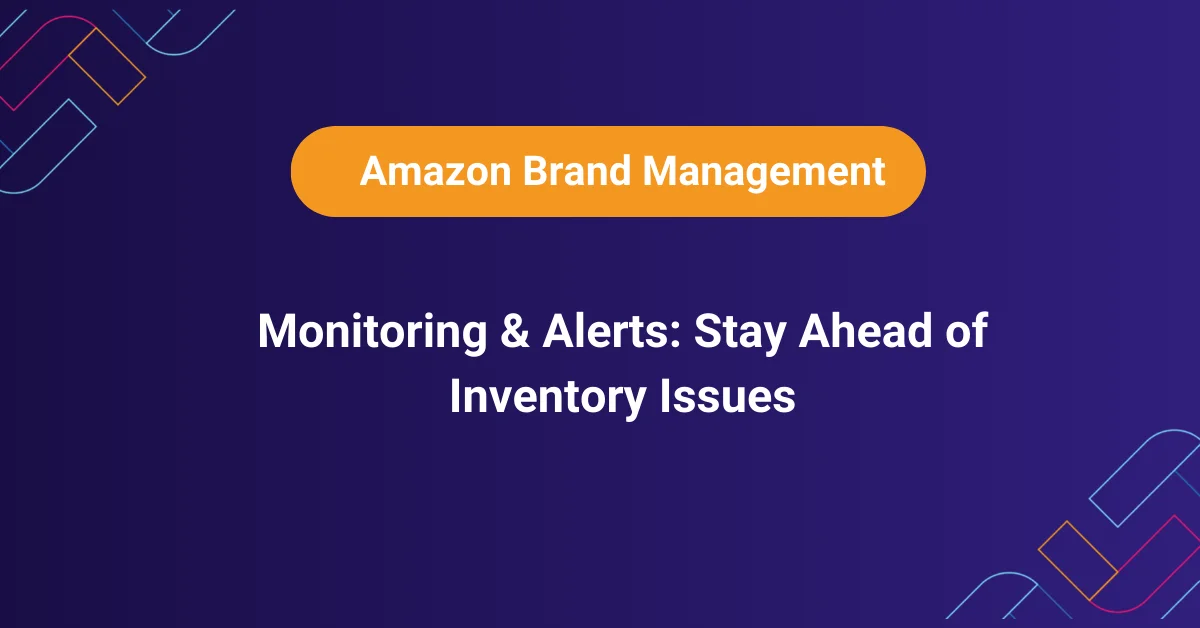Inventory discrepancies can silently erode revenue and frustrate operations teams. When Shopify and Amazon inventories aren’t perfectly aligned, oversells, stockouts, and delayed updates can lead to refunds, negative reviews, and lost customers. Implementing a robust Shopify Amazon inventory sync ensures your stock levels are updated in real time, reducing errors and freeing up cash.
Are you currently losing sales or tying up capital because your Shopify and Amazon inventories are unsynced? How would your operations improve if oversells were eliminated and stockouts prevented through automated, real-time updates?
Why Real-Time Shopify Amazon Inventory Sync Matters
For multi-channel ecommerce brands, the cost of unsynced inventory is more than lost sales—it impacts cash flow, operational efficiency, and customer trust.
- Revenue Loss: Stockouts directly translate to missed sales.
- Customer Experience: Oversells lead to refunds, complaints, and negative reviews.
Tied-Up Capital: Excess safety stock or emergency orders lock up cash unnecessarily.
Labor Inefficiency: Manual reconciliation consumes valuable team hours.
Example:
A 7-figure apparel brand frequently oversold products on Amazon while Shopify showed stock available. After implementing real-time Shopify Amazon inventory sync via middleware, oversells dropped by 90%, freeing cash and improving operational efficiency.
Are your operations still manually reconciling stock between Shopify and Amazon? How would automating this process improve your team’s productivity and reduce costly errors.
How do I sync FBA inventory to Shopify?
Use API-driven middleware or apps to push FBA stock to Shopify in real time.
What’s the best way to prevent overselling across channels?
Implement real-time inventory sync with automated safety buffers and alerts.
FBA vs FBM: Understanding the Trade-Offs
Real-time inventory sync requirements differ depending on your fulfillment model:
FBA (Fulfillment by Amazon) Multi-Channel:
Automatic inventory updates via Amazon API
Reserved inventory may temporarily reduce available stock
Critical to sync with Shopify to prevent oversells
FBM (Fulfilled by Merchant):
Inventory managed through OMS/WMS systems
Manual errors common without automation
Requires real-time updates to Shopify for accuracy
Example:
An 8-figure electronics brand used FBA for Amazon and FBM for Shopify. Without proper sync, oversells were frequent. After implementing middleware that integrated FBA reserves and automated FBM updates, oversells dropped by 70%, and 12 labor hours/week were saved.
Trade-Off Table:
| Fulfillment Type | Pros | Cons | Recommended Sync Approach |
|---|---|---|---|
| FBA | Automatic Amazon updates | Reserve periods can block stock | API or middleware sync with buffer |
| FBM | Full control | Manual errors possible | OMS-driven real-time sync |
What happens to inventory during Amazon reserve?
Architecture Options for Shopify Amazon Inventory Sync
Direct API Integration
Pros: Fast, real-time updates
Cons: Requires development expertise
Middleware Platforms (Brankit, Celigo, Sellbrite)
Pros: Connect multiple channels easily; handle FBA/FBM, kits, bundles
Cons: Subscription costs and setup required
OMS/WMS Driven
Pros: Single source of truth; supports multi-location and 3PL
Cons: More complex setup
Mini-Case Example:
A 9-figure consumer goods brand implemented Brankit middleware connecting Shopify, Amazon, and three 3PL locations. Stockouts dropped 80% and manual reconciliation decreased by 18 hours/week.
How would having a single system automatically reconcile inventory across Shopify, Amazon, and 3PLs reduce errors and free your team’s time?
Can I sync locations and 3PLs too?
Yes, advanced OMS or middleware supports multi-location and multi-3PL inventory updates.
Which apps or integrations work best?
Brankit, Sellbrite, and Celigo are proven for multi-channel real-time inventory sync.
Safety Buffers: Prevent Oversells Without Tying Up Cash
Even with real-time sync, inventory fluctuations and Amazon reserve periods can still cause oversells, which is why implementing robust ecommerce inventory forecasting alongside safety buffers acts as a protective layer to prevent stockouts and ensure consistent customer satisfaction
Key Strategies for Safety Buffers:
Maintain a minimum buffer quantity for high-velocity SKUs.
Adjust buffers dynamically based on sales velocity and seasonality.
Integrate buffer rules directly into your Shopify Amazon inventory sync system.
Example:
A 7-figure beauty brand set a buffer of 10 units per SKU. During peak holiday sales, the buffer prevented oversells that could have caused $50K in lost revenue.
How much would your revenue improve if oversells were virtually eliminated through intelligent buffer management?
Should I keep safety stock buffers?
Yes. Buffers protect against oversells, stockouts, and Amazon reserve fluctuations.
How do I determine optimal buffer levels?
Analyze historical sales velocity, lead times, and fulfillment delays.
Bundles & Kits: Syncing Complex SKUs
Bundled products or kits create unique inventory challenges, which is why using inventory accuracy calculate improve scale fast practices is essential; without careful sync, a sale of a bundle can oversell individual SKUs or deplete stock unexpectedly.
Best Practices:
Use middleware that supports component-level tracking.
Ensure Shopify and Amazon correctly decrement each SKU in a bundle.
Schedule daily or real-time updates for kits to avoid mismatches.
Example:
A 6-figure home goods brand sold kitchen bundles on Shopify and Amazon. After enabling kit-level tracking via Brankit, mismatches dropped from 15% to under 2%, reducing refunds and complaints.
How do kits and bundles sync correctly?
Use middleware or an OMS that tracks individual SKUs and adjusts stock in real time.
Can I sync bundles across multiple channels?
Yes, modern inventory platforms support multi-channel bundle SKU mapping.
Monitoring & Alerts: Stay Ahead of Inventory Issues
Even with automated sync, continuous monitoring is essential. Alerts notify your operations team when anomalies occur, preventing revenue loss.
Recommended Monitoring Strategies:
Set threshold alerts for low stock or negative inventory.
Track API errors or sync failures.
Schedule daily reconciliation reports between Shopify, Amazon, and 3PLs.
Example:
A 9-figure electronics brand implemented automated alerts. One sync failure was detected within minutes, preventing $12K in potential oversells.
How do I audit sync accuracy?
Compare Shopify and Amazon stock daily; use automated reports from middleware or OMS.
What happens if a sync fails?
Alerts notify your team immediately so corrections can be made before oversells occur.

Want a free Supply Chain map?
ROI of Real-Time Shopify Amazon Inventory Sync
Implementing an effective Shopify Amazon inventory sync system can deliver tangible financial and operational benefits:
| Benefit | Example / Impact |
|---|---|
| Reduced Oversells | 70–90% drop, fewer refunds, improved customer satisfaction |
| Stockout Prevention | Maintains revenue, prevents lost sales |
| Labor Savings | 12–20 hours/week saved on manual reconciliation |
| Cash Flow Optimization | Freed up working capital, better inventory turns |
Example:
A 7-figure apparel brand reported a $40K monthly improvement in cash flow and 18 hours/week labor savings after integrating Brankit for Shopify Amazon inventory sync.
How would eliminating manual reconciliation and oversells improve your team’s productivity and your cash flow?
Frequently Asked Questions
While no system can guarantee zero oversells, a robust Shopify Amazon inventory sync dramatically reduces the risk. Combining real-time updates, safety buffers, and alerts ensures your inventory reflects actual stock levels on both channels, minimizing errors and customer complaints.
Yes. Advanced middleware or OMS platforms track each component SKU in a bundle. When a bundle is sold, all related SKUs are decremented in Shopify and Amazon simultaneously, ensuring accurate inventory and preventing oversells
Brankit, Celigo, and Sellbrite are widely used for multi-channel inventory sync. They support FBA/FBM, reserved stock, bundles/kits, safety buffers, and real-time updates across Shopify, Amazon, and other marketplaces.
For multi-channel operations, real-time or near real-time sync is ideal. Some middleware updates every few minutes, while others allow immediate API-driven updates. Frequent syncing prevents oversells, improves cash flow, and enhances customer trust.
Yes. Most platforms provide automated notifications for low stock, sync failures, or negative inventory. Alerts allow your team to address issues immediately, preventing oversells and operational disruptions.
Middleware or OMS platforms automatically account for reserved FBA stock. Shopify will show only available inventory, preventing overselling and ensuring accurate stock visibility across all channels.
Minimal manual reconciliation is required. With proper setup, real-time sync handles most updates automatically. Occasional audits are recommended to ensure data integrity and verify multi-location or bundle adjustments.
Call To Action
Implementing a reliable Shopify Amazon inventory sync can eliminate costly oversells, improve cash flow, and boost operational efficiency.
Schedule a Call with a Brankit supply chain expert today to evaluate your current setup and start syncing your inventory in real time.





